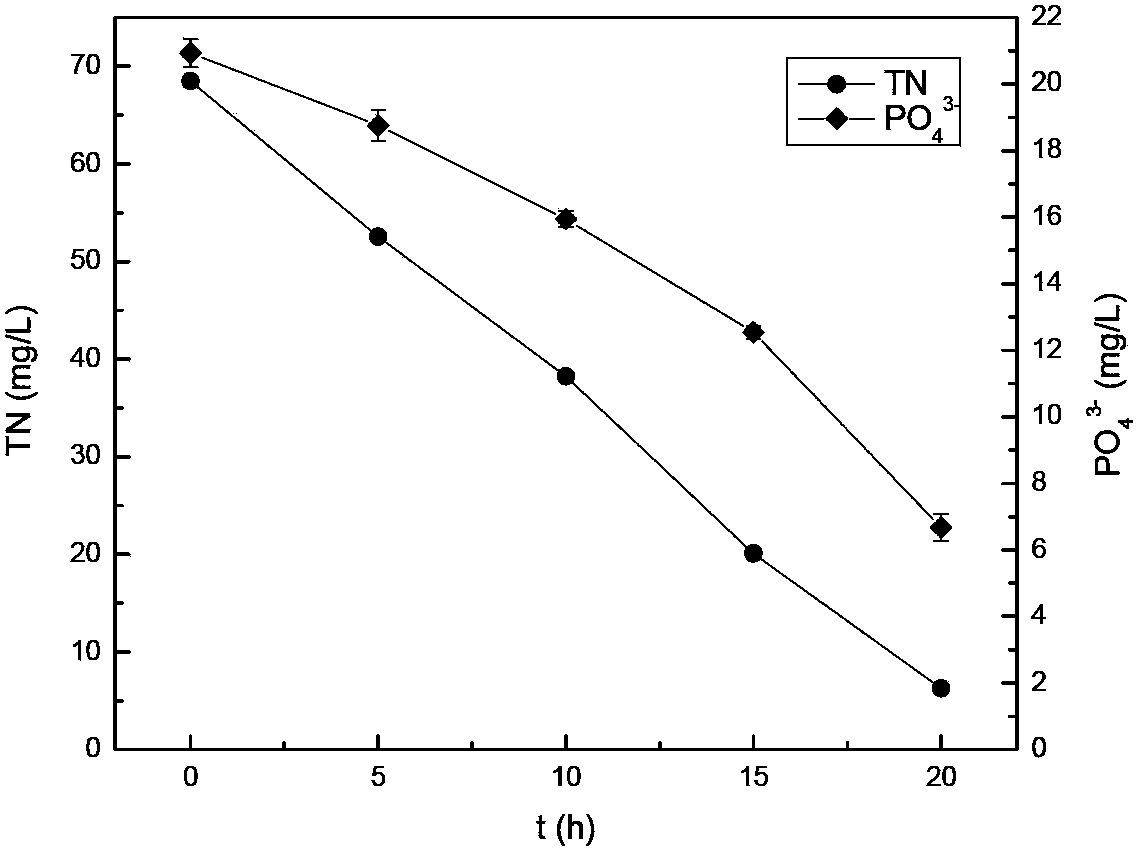Acinetobacter johnsonii bacterial strain capable of low-temperature synchronous denitrification phosphorous removal and application thereof
A technology of Acinetobacter johnsoni, nitrogen and phosphorus removal, applied in the direction of bacteria, microorganism-based methods, biological water/sewage treatment, etc., can solve the problem that nitrate nitrogen and nitrite nitrogen cannot be effectively removed, and the total nitrogen in the effluent is difficult to reach the standard , increasing operating costs and other issues, to achieve the effect of saving infrastructure investment and operating costs, broad application prospects, and simplifying the process
- Summary
- Abstract
- Description
- Claims
- Application Information
AI Technical Summary
Problems solved by technology
Method used
Image
Examples
Embodiment 1
[0033] Example 1. Temperature characteristics of bacterial strain HA7
[0034] Investigate the growth performance of the strain under different temperature conditions of 10°C, 15°C, 20°C, 25°C, and 30°C. The specific implementation steps are as follows:
[0035] Inoculate strain HA7 in 150ml of BM medium (containing sodium acetate per liter: 2.73g, NH 4 Cl: 0.306g, KH 2 PO 4 : 0.1g, MgSO 4 ·7H 2 O: 0.1g, FeSO 4 ·7H 2 O: 0.001g, pH: 7.0-7.3, steam sterilized at 121°C for 20 minutes), and pre-cultivated on a shaker at 10°C, 15°C, 20°C, 25°C, 30°C, 160r / min. When the strain grows to the late logarithmic phase, take 10ml of the bacterial liquid and put it into 150ml of fresh BM medium, and carry out shaking culture at 10°C, 15°C, 20°C, 25°C, 30°C, and 160r / min. Take the reaction solution at regular intervals and measure the OD 600 , to characterize the growth of the strain.
[0036] The result is as figure 1 As shown, the strains grow best between 20°C and 30°C, the grow...
Embodiment 2
[0037] Example 2. Removal of Phosphate and Nitrogen by Strain HA7 at 10°C
[0038] Using sodium acetate as the organic carbon source, ammonia nitrogen as the nitrogen source, and phosphate as the phosphorus source, the nitrogen and phosphorus removal capabilities of the strain HA7 were determined. The specific implementation steps are as follows:
[0039] The strain HA7 was inoculated in 150ml of BM medium, and pre-cultivated on a shaker at 10°C and 160r / min. When the strain grows to the late logarithmic growth phase, take 10ml of the bacterial liquid and put it into fresh 150ml BM medium, and carry out shaking culture at 10°C and 160r / min. The reaction solution was taken at regular intervals, and after being centrifuged at 8000 rpm for 10 minutes, the supernatant was taken to measure the concentration of various nitrogen-containing compounds and phosphate.
[0040] The result is as figure 2It can be seen that the concentrations of nitrogen and phosphorus decreased continu...
Embodiment 3
[0041] Example 3. Removal of nitrogen by bacterial strain HA7 at different temperatures
[0042] The denitrification performance of the strain was investigated at different temperatures of 10°C, 15°C, 20°C, 25°C, and 30°C. The specific implementation steps are as follows:
[0043] The strain HA7 was inoculated in 150ml of BM medium, and pre-cultured on a shaker at 10°C, 15°C, 20°C, 25°C, 30°C, 160r / min. When the strain grows to the late logarithmic phase, take 10ml of the bacterial liquid and put it into 150ml of fresh BM medium, and carry out shaking culture at 10°C, 15°C, 20°C, 25°C, 30°C, and 160r / min respectively. The reaction solution was taken at regular intervals, and after being centrifuged at 8000 rpm for 10 minutes, the supernatant was taken to measure the concentration of various nitrogen-containing compounds.
[0044] The result is as image 3 As shown, the strain can effectively remove total nitrogen in the temperature range of 10°C-30°C. At 20°C, the average r...
PUM
 Login to View More
Login to View More Abstract
Description
Claims
Application Information
 Login to View More
Login to View More - R&D
- Intellectual Property
- Life Sciences
- Materials
- Tech Scout
- Unparalleled Data Quality
- Higher Quality Content
- 60% Fewer Hallucinations
Browse by: Latest US Patents, China's latest patents, Technical Efficacy Thesaurus, Application Domain, Technology Topic, Popular Technical Reports.
© 2025 PatSnap. All rights reserved.Legal|Privacy policy|Modern Slavery Act Transparency Statement|Sitemap|About US| Contact US: help@patsnap.com



